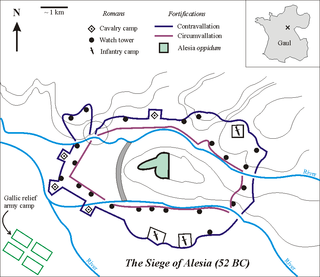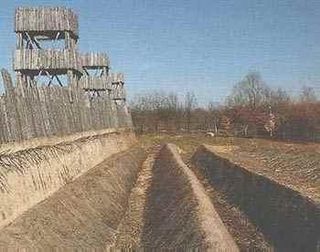The Aedui or Haedui were a Gallic tribe dwelling in the modern Burgundy region during the Iron Age and the Roman period.

Vercingetorix was a Gallic king and chieftain of the Arverni tribe who united the Gauls in a failed revolt against Roman forces during the last phase of Julius Caesar's Gallic Wars. Despite having willingly surrendered to Caesar, he was executed in Rome.

This article concerns the period 59 BC – 50 BC.

Gaul was a region of Western Europe first clearly described by the Romans, encompassing present-day France, Belgium, the Netherlands, Luxembourg, and parts of Switzerland, Germany, and Northern Italy. It covered an area of 494,000 km2 (191,000 sq mi). According to Julius Caesar, who took control of the region on behalf of the Roman Republic, Gaul was divided into three parts: Gallia Celtica, Belgica, and Aquitania.

Commentarii de Bello Gallico, also Bellum Gallicum, is Julius Caesar's firsthand account of the Gallic Wars, written as a third-person narrative. In it Caesar describes the battles and intrigues that took place in the nine years he spent fighting the Celtic and Germanic peoples in Gaul that opposed Roman conquest.

Year 52 BC was a year of the pre-Julian Roman calendar. At the time, it was known as the Year of the Consulship of Pompeius and Scipio. The denomination 52 BC for this year has been used since the early medieval period, when the Anno Domini calendar era became the prevalent method in Europe for naming years.

The Gallic Wars were waged between 58 and 50 BC by the Roman general Julius Caesar against the peoples of Gaul. Gallic, Germanic, and British tribes fought to defend their homelands against an aggressive Roman campaign. The Wars culminated in the decisive Battle of Alesia in 52 BC, in which a complete Roman victory resulted in the expansion of the Roman Republic over the whole of Gaul. Though the Gallic military was as strong as the Romans, the Gallic tribes' internal divisions eased victory for Caesar. Gallic chieftain Vercingetorix's attempt to unite the Gauls under a single banner came too late. Caesar portrayed the invasion as being a preemptive and defensive action, but historians agree that he fought the Wars primarily to boost his political career and to pay off his debts. Still, Gaul was of significant military importance to the Romans. Native tribes in the region, both Gallic and Germanic, had attacked Rome several times. Conquering Gaul allowed Rome to secure the natural border of the river Rhine.

The Arverni were a Gallic people dwelling in the modern Auvergne region during the Iron Age and the Roman period. They were one of the most powerful tribes of ancient Gaul, contesting primacy over the region with the neighbouring Aedui.

The Battle of Alesia or Siege of Alesia was the climactic military engagement of the Gallic Wars, fought around the Gallic oppidum of Alesia in modern France, a major centre of the Mandubii tribe. It was fought by the Roman army of Julius Caesar against a confederation of Gallic tribes united under the leadership of Vercingetorix of the Arverni. It was the last major engagement between Gauls and Romans, and is considered one of Caesar's greatest military achievements and a classic example of siege warfare and investment; the Roman army built dual lines of fortifications – an inner wall to keep the besieged Gauls in, and an outer wall to keep the Gallic relief force out. The Battle of Alesia marked the end of Gallic independence in the modern day territory of France and Belgium.

The Bituriges Cubi were a Gallic tribe dwelling in a territory corresponding to the later province of Berry, which is named after them, during the Iron Age and the Roman period. They had a homonym tribe, the Bituriges Vivisci, in the Bordelais region, which could indicate a common origin, although there is no direct evidence of this.

Gergovia was a Gaulish town in modern Auvergne-Rhône-Alpes in the upper part of the basin of the Allier, near present-day Clermont-Ferrand. It was the capital of the Averni. The city of Gergovia had strong walls, and was located on a giant raised plateau surrounded by hills.
The Battle of Gergovia took place in 52 BC in Gaul at Gergovia, the chief oppidum of the Arverni. The battle was fought between a Roman Republican army, led by proconsul Julius Caesar, and Gallic forces led by Vercingetorix, who was also the Arverni chieftain. The Romans attempted to besiege Gergovia, but miscommunication ruined the Roman plan. The Gallic cavalry counterattacked the confused Romans and sent them to flight, winning the battle.

Dumnorix was a chieftain of the Aedui, a Celtic tribe in Gaul in the 1st century B.C. He was the younger brother of Divitiacus, the Aedui druid and statesman.

Roman Gaul refers to Gaul under provincial rule in the Roman Empire from the 1st century BC to the 5th century AD.

Druids is a 2001 epic historical drama film directed by Jacques Dorfmann. It stars Christopher Lambert, Klaus Maria Brandauer, Inés Sastre, Maria Kavardjikova, Bernard-Pierre Donnadieu, and Max von Sydow.

Avaricum was an oppidum in ancient Gaul, near what is now the city of Bourges. Avaricum, situated in the lands of the Bituriges Cubi, was the largest and best-fortified town within their territory, situated on very fertile lands. The terrain favored the oppidum, as it was flanked by a river and marshland, with only a single narrow entrance. By the time of the Roman conquest in 52 BC the city according to Julius Caesar had a population of 40,000 people who were then almost all killed.
Litaviccus was a member of the Gallic tribe of Aedui. He played an important role at the Siege of Gergovia. Though the Aedui at first supported Julius Caesar in his struggle against Vercingetorix, they defected from the Romans and joined Vercingetorix.

Lucterius was a leader of the Cadurci, a Celtic people whose territory was located around Cahors in the modern French department of Lot. In the 50s BC, the Cadurci were under the rule of the Arverni, the civitas of Vercingetorix, under whom Lucterius served during the last stages of the Gallic Wars. In his memoirs, Julius Caesar calls him a man of unsurpassed boldness.

The military campaigns of Julius Caesar constituted both the Gallic Wars and Caesar's civil war. The Gallic War mainly took place in what is now France. In 55 and 54 BC, he invaded Britain, although he made little headway. The Gallic War ended with complete Roman victory at the Battle of Alesia. This was followed by the civil war, during which time Caesar chased his rivals to Greece, decisively defeating them there. He then went to Egypt, where he defeated the Egyptian pharaoh and put Cleopatra on the throne. He then finished off his Roman opponents in Africa and Hispania. Once his campaigns were over, he served as Roman dictator until his assassination on 15 March 44 BC. These wars were critically important in the transition of the Roman Republic into the Roman Empire.
The Druid King is a 2003 historical novel by American novelist Norman Spinrad. The novel is set during the Gallic Campaigns of Julius Caesar. The main protagonist of the novel is Vercingetorix and the plot follows his rise to power to become king of the Gauls and his eventual surrender to Caesar at the Battle of Alesia. The book is a novelisation of an early version of the script for Vercingétorix, la Légende du Druide Roi, a French language film.















